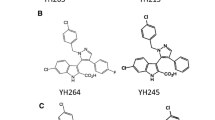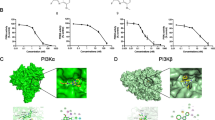Abstract
Purpose
Protein kinase D (PKD) mediates diverse biological responses including cell growth and survival. Therefore, PKD inhibitors may have therapeutic potential. We evaluated the in vitro cytotoxicity of two PKD inhibitors, kb-NB142-70 and its methoxy analogue, kb-NB165-09, and examined their in vivo efficacy and pharmacokinetics.
Methods
The in vitro cytotoxicities of kb-NB142-70 and kb-NB165-09 were evaluated by MTT assay against PC-3, androgen-independent prostate cancer cells, and CFPAC-1 and PANC-1, pancreatic cancer cells. Efficacy studies were conducted in mice bearing either PC-3 or CPFAC-1 xenografts. Tumor-bearing mice were euthanized between 5 and 1,440 min after iv dosing, and plasma and tissue concentrations were measured by HPLC–UV. Metabolites were characterized by LC–MS/MS.
Results
kb-NB142-70 and kb-NB165-09 inhibited cellular growth in the low–mid μM range. The compounds were inactive when administered to tumor-bearing mice. In mice treated with kb-NB142-70, the plasma C max was 36.9 nmol/mL, and the PC-3 tumor C max was 11.8 nmol/g. In mice dosed with kb-NB165-09, the plasma C max was 61.9 nmol/mL, while the PANC-1 tumor C max was 8.0 nmol/g. The plasma half-lives of kb-NB142-70 and kb-NB165-09 were 6 and 14 min, respectively. Both compounds underwent oxidation and glucuronidation.
Conclusions
kb-NB142-70 and kb-NB165-09 were rapidly metabolized, and concentrations in tumor were lower than those required for in vitro cytotoxicity. Replacement of the phenolic hydroxyl group with a methoxy group increased the plasma half-life of kb-NB165-09 2.3-fold over that of kb-NB142-70. Rapid metabolism in mice suggests that next-generation compounds will require further structural modifications to increase potency and/or metabolic stability.




Similar content being viewed by others
References
Rennecke J, Rehberger PA, Fürstenberger G, Johannes FJ, Stöhr M, Marks F, Richter KH (1999) Protein-kinase-Cmu expression correlates with enhanced keratinocyte proliferation in normal and neoplastic mouse epidermis and in cell culture. Int J Cancer 80:98–103
Zhukova E, Sinnett-Smith J, Rozengurt E (2001) Protein kinase D potentiates DNA synthesis and cell proliferation induced by bombesin, vasopressin, or phorbol esters in swiss 3T3 cells. J Biol Chem 276:40298–40305
Johannes FJ, Horn J, Link G, Haas E, Siemienski K, Wajant H, Pfizenmaier K (1998) Protein kinase Cmu downregulation of tumor-necrosis-factor-induced apoptosis correlates with enhanced expression of nuclear-factor-kappaB-dependent protective genes. Eur J Biochem 257:47–54
Endo K, Oki E, Biedermann V, Kojima H, Yoshida K, Johannes FJ, Kufe D, Datta R (2000) Proteolytic cleavage and activation of protein kinase C [micro] by caspase-3 in the apoptotic response of cells to 1-beta-d-arabinofuranosylcytosine and other genotoxic agents. J Biol Chem 275:18476–18481
Brändlin I, Hübner S, Eiseler T, Martinez-Moya M, Horschinek A, Hausser A, Link G, Rupp S, Storz P, Pfizenmaier K, Johannes FJ (2002) Protein kinase C (PKC)eta-mediated PKC mu activation modulates ERK and JNK signal pathways. J Biol Chem 277:6490–6496
Rey O, Young SH, Cantrell D, Rozengurt E (2001) Rapid protein kinase D translocation in response to G protein-coupled receptor activation. J Biol Chem 276:32616–32626
Paolucci L, Rozengurt E (1999) Protein kinase D in small cell lung cancer cells: rapid activation through protein kinase C. Cancer Res 59:572–577
Sidorenko SP, Law CL, Klaus SJ, Chandran KA, Takata M, Kurosaki T, Clark EA (1996) Protein kinase C mu (PKC mu) associates with the B cell antigen receptor complex and regulates lymphocyte signaling. Immunity 5:353–363
Rozengurt E, Sinnett-Smith J, Van Lint J, Valverde AM (1995) Protein kinase D: a novel target for diacylglycerol and phorbol esters. Mutat Res 326:545–551
Haworth RS, Sinnett-Smith J, Rozengurt E, Avkiran M (1999) Protein kinase D inhibits plasma membrane Na+/H+ exchanger activity. Am J Physiol 277:C1202–C1209
Rykx A, Kimpe LD, Mikhalap S, Vantus T, Seufferlein T, Vandenheede JR, Lint JV (2003) Protein kinase D: a family affair. FEBS Lett 546:81–86
Eiseler T, Döppler H, Yan IK, Goodison S, Storz P (2009) Protein kinase D1 regulates matrix metalloproteinase expression and inhibits breast cancer cell invasion. Breast Cancer Res 11(1):R13
Papazyan R, Rozengurt E, Rey O (2006) The C-terminal tail of protein kinase D2 and protein kinase D3 regulates their intracellular distribution. Biochem Biophys Res Commun 342(3):685–689
Lu G, Chen J, Espinoza LA, Garfield S, Toshiyuki S, Akiko H, Huppler A, Wang QJ (2007) Protein kinase D 3 is localized in vesicular structures and interacts with vesicle-associated membrane protein 2. Cell Signal 19(4):867–879
Marklund U, Lightfoot K, Cantrell D (2003) Intracellular location and cell context-dependent function of protein kinase D. Immunity 19(4):491–501
Hassan S, Biswas MH, Zhang C, Du C, Balaji KC (2009) Heat shock protein 27 mediates repression of androgen receptor function by protein kinase D1 in prostate cancer cells. Oncogene 28(49):4386–4396
Matthews SA, Navarro MN, Sinclair LV, Emslie E, Feijoo-Carnero C, Cantrell DA (2010) Unique functions for protein kinase D1 and protein kinase D2 in mammalian cells. Biochem J 432(1):153–163
American Cancer Society: Cancer Facts and Figures 2009. Atlanta, Ga: American Cancer Society, 2009. Also available online. Last accessed May 7, 2009
Amadesi S, Grant AD, Cottrell GS, Vaksman N, Poole DP, Rozengurt E, Bunnett NW (2009) Protein kinase D isoforms are expressed in rat and mouse primary sensory neurons and are activated by agonists of protease-activated receptor 2. J Comp Neurol 516(2):141–156
Chen LA, Li J, Silva SR, Jackson LN, Zhou Y, Watanabe H, Ives KL, Hellmich MR, Evers BM (2009) PKD3 is the predominant protein kinase D isoform in mouse exocrine pancreas and promotes hormone-induced amylase secretion. J Biol Chem 284(4):2459–2471
Rey O, Yuan J, Rozengurt E (2003) Intracellular redistribution of protein kinase D2 in response to G-protein-coupled receptor agonists. Biochem Biophys Res Commun 302:817–824
Rey O, Yuan J, Young SH, Rozengurt E (2003) Protein kinase C nu/protein kinase D3 nuclear localization, catalytic activation, and intracellular redistribution in response to G protein-coupled receptor agonists. J Biol Chem 278:23773–23785
Yuan J, Rozengurt E (2008) PKD, PKD2, and p38 MAPK mediate Hsp27 serine-82 phosphorylation induced by neurotensin in pancreatic cancer PANC-1 cells. J Cell Biochem 103(2):648–662
Seufferlein T (2002) Novel protein kinases in pancreatic cell growth and cancer. Int J Gastrointest Cancer 31(1–3):15–21
Guha S, Rey O, Rozengurt E (2002) Neurotension induces protein kinase C-dependent protein kinase D activation and DNA synthesis in human pancreatic carcinoma cell line PANC-1. Cancer Res 62:1632–1640
Du C, Jaggi M, Zhang C, Balaji KC (2009) Protein kinase D1-mediated phosphorylation and subcellular localization of beta-catenin. Cancer Res 69(3):1117–1124
Mak P, Jaggi M, Syed V, Chauhan SC, Hassan S, Biswas H, Balaji KC (2008) Protein kinase D1 (PKD1) influences androgen receptor (AR) function in prostate cancer cells. Biochem Biophys Res Commun 373(4):618–623
Chen J, Deng F, Singh SV, Wang QJ (2008) Protein kinase D3 (PKD3) contributes to prostate cancer cell growth and survival through a PKCepsilon/PKD3 pathway downstream of Akt and ERK 1/2. Cancer Res 68(10):3844–3853
Sturany S, Lint JV, Gilchrist A, Vandenheede JR, Adler G, Seufferlein T (2002) Mechanism of activation of protein kinase D2(PKD2) by the CCKB/gastrin receptor. J Biol Chem 277:29431–29436
Jaggi M, Rao PS, Smith DJ, Wheelock MJ, Johnson KR, Hemstreet GP, Balaji KC (2005) E-cadherin phosphorylation by protein kinase D1/protein kinase C{mu} is associated with altered cellular aggregation and motility in prostate cancer. Cancer Res 65:483–492
Harikumar KB, Kunnumakkara AB, Ochi N, Tong Z, Deorukhkar A, Sung B, Kelland L, Jamieson S, Sutherland R, Raynham T, Charles M, Bagherzadeh A, Foxton C, Boakes A, Farooq M, Maru D, Diagaradjane P, Matsuo Y, Sinnett-Smith J, Gelovani J, Krishnan S, Aggarwal BB, Rozengurt E, Ireson CR, Guha S (2010) A novel small-molecule inhibitor of protein kinase D blocks pancreatic cancer growth in vitro and in vivo. Mol Cancer Ther 9:1136–1145
Stewart JR, Christman KL, O’Brian CA (2000) Effects of resveratrol on the autophosphorylation of phorbol ester-responsive protein kinases: inhibition of protein kinase D but not protein kinase C isozyme autophosphorylation. Biochem Pharmacol 60(9):1355–1359
Sharlow ER, Giridhar KV, LaValle CR, Chen J, Leimgruber S, Barrett R, Bravo-Altamirano K, Wipf P, Lazo JS, Wang QJ (2008) Potent and selective disruption of protein kinase D functionality by a benzoxoloazepinolone. J Biol Chem 283(48):33516–33526
LaValle CR, Bravo-Altamirano K, Giridhar KV, Chen J, Sharlow E, Lazo JS, Wipf P, Wang QJ (2010) Novel protein kinase D inhibitors cause potent arrest in prostate cancer cell growth and motility. BMC Chem Biol 10:5
Bravo-Altamirano K, George KM, Frantz MC, Lavalle CR, Tandon M, Leimgruber S, Sharlow ER, Lazo JS, Wang QJ, Wipf P (2011) Synthesis and structure-activity relationships of benzothienothiazepinone inhibitors of protein kinase D. ACS Med Chem Lett 2(2):154–159
George KM, Frantz M-CL, Bravo-Altamirano K, Lavalle CR, Tandon M, Leimgruber S, Sharlow ER, Lazo JS, Wang QJ, Wipf P (2011) Design, synthesis, and biological evaluation of PKD inhibitors. Pharmaceutics 3(2):186–228
D’Argenio DZ, Schumitzky A. ADAPT, Biomedical Simulation Resource, USC. bmsr.usc.edu/Software/ADAPT/ADAPT.html
Yeh KC, Kwan KC (1978) A comparison of numerical integrating algorithms by trapezoidal, Lagrange, and spline approximation. J Pharmacokinet Biopharm 6:79–98
Rocci ML, Jusko WJ (1983) LAGRAN program for area and moments in pharmacokinetic analysis. Comput Programs Biomed 16:203–216
Brown RP, Delp MD, Lindstedt SL, Rhomberg LR, Beliles RP (1997) Physiological parameter values for physiologically based pharmacokinetic models. Toxicol Ind Health 13:407–484
LaValle CR, George KM, Sharlow ER, Lazo JS, Wipf P, Wang QJ (2010) Protein kinase D as a potential new target for cancer therapy. Biochim Biophys Acta 1806:183–192
Ochi N, Tanasanvimon S, Matsuo Y, Tong Z, Sung B, Aggarwal BB, Sinnett-Smith J, Rozengurt E, Guha S (2011) Protein kinase D1 promotes anchorage-independent growth, invasion, and angiogenesis by human pancreatic cancer cells. J Cell Physiol 226:1074–1081
Ristich VL, Bowman PH, Dodd ME, Bollag WB (2006) Protein kinase D distribution in normal human epidermis, basal cell carcinoma and psoriasis. Br J Dermatol 154:586–593
Kisfalvi K, Hurd C, Guha S, Rozengurt E (2010) Induced overexpression of protein kinase D1 stimulates mitogenic signaling in human pancreatic carcinoma PANC-1 cells. J Cell Physiol 223:309–316
Chen J, Giridhar KV, Zhang L, Xu S, Wang QJ (2011) A protein kinase C/protein kinase D pathway protects LNCaP prostate cancer cells from phorbol ester-induced apoptosis by promoting ERK1/2 and NF-{kappa}B activities. Carcinogenesis 32:1198–1206
Acknowledgments
This study was supported in part by US Public Health Service National Institutes of Health grant CA78039, CA129127, and CA142580. This project used the UPCI Clinical Pharmacology Analytical Facility (CPAF) and was supported in part by award P01CA078039. We acknowledge Diane Mazzei and other members of DLAR for the excellent care of the animals used in these studies. We also acknowledge the UPCI Writing Group for their helpful comments.
Author information
Authors and Affiliations
Corresponding author
Electronic supplementary material
Below is the link to the electronic supplementary material.
Rights and permissions
About this article
Cite this article
Guo, J., Clausen, D.M., Beumer, J.H. et al. In vitro cytotoxicity, pharmacokinetics, tissue distribution, and metabolism of small-molecule protein kinase D inhibitors, kb-NB142-70 and kb-NB165-09, in mice bearing human cancer xenografts. Cancer Chemother Pharmacol 71, 331–344 (2013). https://doi.org/10.1007/s00280-012-2010-z
Received:
Accepted:
Published:
Issue Date:
DOI: https://doi.org/10.1007/s00280-012-2010-z




